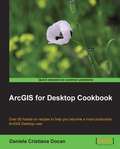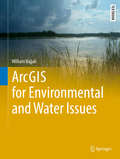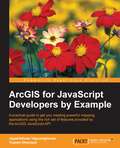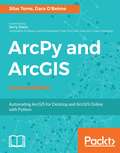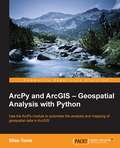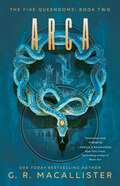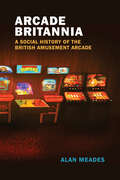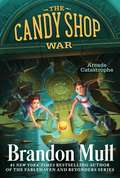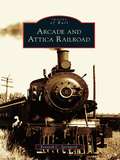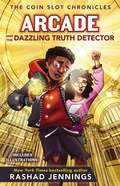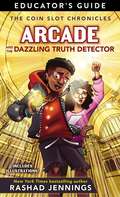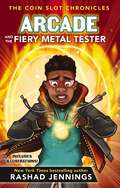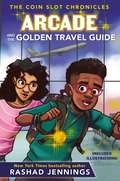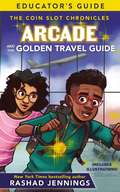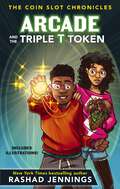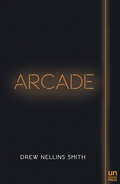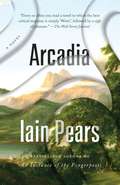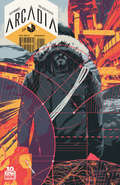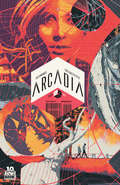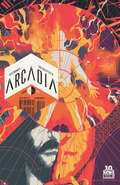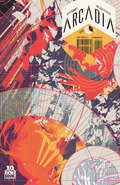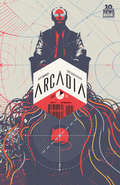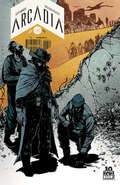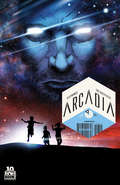- Table View
- List View
ArcGIS for Desktop Cookbook
by Daniela Cristiana DocanThis book is a good companion to get you quickly acquainted with everything you need to increase your productivity with the ArcGIS Desktop. It would be helpful to have a bit of familiarity with basic GIS concepts. If you have no previous experience with ArcGIS, this book will still be helpful for you because it will help you catch up to the acquainted users from a practical point of view.
ArcGIS for Environmental and Water Issues (Springer Textbooks In Earth Sciences, Geography And Environment Ser.)
by William BajjaliThis textbook is a step-by-step tutorial on the applications of Geographic Information Systems (GIS) in environmental and water resource issues. It provides information about GIS and its applications, specifically using the most advanced ESRI GIS technology and its extensions. Eighteen chapters cover GIS applications in the field of earth sciences and water resources in detail from the ground up. Author William Bajjali explains what a GIS is and what it is used for, the basics of map classification, data acquisition, coordinate systems and projections, vectorization, geodatabase and relational database, data editing, geoprocessing, suitability modeling, working with raster, watershed delineation, mathematical and statistical interpolation, and more advanced techniques, tools and extensions such as ArcScan, Topology, Geocoding, Hydrology, Geostatistical Analyst, Spatial Analyst, Network Analyst, 3-D Analyst. ArcPad, ESRI's cutting-edge mobile GIS software, is covered in detail as well. Each chapter contains concrete case studies and exercises - many from the author's own work in the United States and Middle East. This volume is targeted toward advanced undergraduates, but could also be useful for professionals and for anyone who utilizes GIS or practices spatial analysis in relation to geology, hydrology, ecology, and environmental sciences.
ArcGIS for JavaScript Developers by Example
by Jayakrishnan Vijayaraghavan Yogesh DhanapalA practical guide to get you creating powerful mapping applications using the rich set of features provided by the ArcGIS JavaScript API About This Book * Unshackle your GIS application from a workstation! Get running with three major web mapping projects covering all the important aspects of the ArcGIS JavaScript API. * Set a strong foundation for the ArcGIS JavaScript API and modular coding with dojo. * Gain a crystal clear understanding of the ArcGIS JavaScript, and become skilled in creating exciting and interesting geospatial apps. Who This Book Is For This book is for JavaScript developers who wish to develop amazing mapping applications using the rich set of features provided by the ArcGIS JavaScript API, but more than that, a spatial frame of mind will help a long way. What You Will Learn * Find out what you need to develop a web mapping application in the ArcGIS environment * Get to know about the major features provided by the ArcGIS JavaScript API * See the coding best practices to develop modular dojo-based JavaScript applications * Get to grips with writing custom re-usable dojo modules using dojo and esri modules and dijits * Understand how to use various ArcGIS data sources and other open geospatial data available on the web * Discover how to query spatial data and get the best out of your data using analytical techniques * Master the art of rendering your map beautifully and create wonderful data visualizations using non-map objects such as charts * Grasp how to create secure and scalable web maps In Detail The book starts by explaining the basics of the ArcGIS web mapping ecosystem. The book walks you through the development of six major applications, covering a wide variety of topics such as querying, rendering, advanced data visualization and performing map analytics. It also emphasizes on writing modular code using pure dojo, which is the preferred platform for developing web GIS applications using ArcGIS JavaScript API. By the end of the book, you will have gained enough practical experience to architect a robust and visually powerful mapping application using the API. Style and approach This is a practical, hands-on guide on using the ArcGIS JavaScript API to develop mapping applications. It is packed with three progressively challenging and diverse projects that explain the plethora of API and dojo topics.
ArcPy and ArcGIS - Second Edition
by Silas Toms Dara O'BeirneUse Python modules such as ArcPy, ArcREST and the ArcGIS API for Python to automate the analysis and mapping of geospatial data. About This Book • Perform GIS analysis faster by automating tasks. • Access the spatial data contained within shapefiles and geodatabases and transform between spatial reference systems. • Automate the mapping of geospatial analyses and production of map books. Who This Book Is For If you are a GIS student or professional who needs an understanding of how to use ArcPy to reduce repetitive tasks and perform analysis faster, this book is for you. It is also a valuable book for Python programmers who want to understand how to automate geospatial analyses and implement ArcGIS Online data management. What You Will Learn • Understand how to integrate Python into ArcGIS and make GIS analysis faster and easier. • Create Python script using ArcGIS ModelBuilder. • Learn to use ArcGIS online feature services and the basics of the ArcGIS REST API • Understand the unique Python environment that is new with ArcGIS Pro • Learn about the new ArcGIS Python API and how to use Anaconda and Jupyter with it • Learn to control ArcGIS Enterprise using ArcPy In Detail ArcGIS allows for complex analyses of geographic information. The ArcPy module is used to script these ArcGIS analyses, providing a productive way to perform geo-analyses and automate map production. The second edition of the book focuses on new Python tools, such as the ArcGIS API for Python. Using Python, this book will guide you from basic Python scripting to advanced ArcPy script tools. This book starts off with setting up your Python environment for ArcGIS automation. Then you will learn how to output maps using ArcPy in MXD and update feature class in a geodatabase using arcpy and ArcGIS Online. Next, you will be introduced to ArcREST library followed by examples on querying, updating and manipulating ArcGIS Online feature services. Further, you will be enabling your scripts in the browser and directly interacting with ArcGIS Online using Jupyter notebook. Finally, you can learn ways to use of ArcPy to control ArcGIS Enterprise and explore topics on deployments, data quality assurances, data updates, version control, and editing safeguards. By the end of the book, you will be equipped with the knowledge required to create automated analysis with administration reducing the time-consuming nature of GIS. Style and approach The book takes a pragmatic approach, showing ways to automate repetitive tasks and utilizing features of ArcPy with ArcGIS Pro and ArcGIS online.
ArcPy and ArcGIS – Geospatial Analysis with Python
by Silas TomsIf you are a GIS student or professional who needs an understanding of how to use ArcPy to reduce repetitive tasks and perform analysis faster, this book is for you. It is also a valuable book for Python programmers who want to understand how to automate geospatial analyses.
Arca (Five Queendoms, The #2)
by G.R. MacallisterReturn to the Five Queendoms in the sequel to Scorpica, a sweeping epic fantasy that Rebecca Roanhorse called &“ambitious and engaging,&” in which a centuries-long peace is shattered in a matriarchal society when a decade passes without a single girl being born.The Drought of Girls has ended, but the rift it broke open between the Queendoms is not so easily healed. Political tensions roil the senate of Paxim, where Queen Heliane vows to make her son Paulus the nation&’s first ruling King or die trying. Scorpican troops amass on the border of Arca, ready to attack. And within Arca itself, its young, unready queen finds her court a nest of vipers and her dreams besieged by a mysterious figure with unknown intentions. As iron and magic clash on the battlefield and powerful women scheme behind the scenes, danger and violence abound. Can anyone stop the chaos from ripping the Queendoms apart?
Arcade Britannia: A Social History of the British Amusement Arcade (Game Histories)
by Alan MeadesThe story of the British amusement arcade from the 1800s to the present.Amusement arcades are an important part of British culture, yet discussions of them tend to be based on American models. Alan Meades, who spent his childhood happily playing in British seaside arcades, presents the history of the arcade from its origins in traveling fairs of the 1800s to the present. Drawing on firsthand accounts of industry members and archival sources, including rare photographs and trade publications, he tells the story of the first arcades, the people who made the machines, the rise of video games, and the legislative and economic challenges spurred by public fears of moral decline. Arcade Britannia highlights the differences between British and North American arcades, especially in terms of the complex relationship between gambling and amusements. He also underlines Britain&’s role in introducing coin-operated technologies into Europe, as well as the industry&’s close links to America and, especially, Japan. He shows how the British arcade is a product of centuries of public play, gambling, entrepreneurship, and mechanization. Examining the arcade&’s history through technological, social, cultural, biographic, and legislative perspectives, he describes a pendulum shift between control and liberalization, as well as the continued efforts of concerned moralists to limit and regulate public play. Finally, he recounts the impact on the industry of legislative challenges that included vicious taxation, questions of whether copyright law applied to video-game code, and the peculiar moment when every arcade game in Britain was considered a cinema.
Arcade Catastrophe (Candy Shop War #2)
by Brandon MullArcadeland is full of magical secrets as well as fun and games in the second book in the Candy Shop War series, from the #1 "New York Times "bestselling author of the Beyonders and Fablehaven series. Nate and his friends already know Mrs. White, the owner of the Sweet Tooth Ice Cream & Candy Shoppe, where the treats are magical in addition to delicious. And now they're introduced to Mrs. White's brother, Mr. White, who owns a local amusement center called Arcadeland. At Arcadeland, kids can play games and earn thousands of tickets that are redeemable for one of four kinds of stamps: jets, tanks, subs, and racecars. Could it be true that these stamps allow kids to fly through the air? Or breathe underwater? Or run faster than a car? But Mr. White is hiding a secret: when all four stamp clubs are filled, he will be able to retrieve perhaps the most powerful talisman ever. For Nate and his friends, it will take more than candy to fight and win this war.
Arcade and Attica Railroad
by Kenneth C. SpringirthIn 1881, a narrow-gauge railroad was built in southwestern New York, from Attica to Arcade. It was later rebuilt to standard gauge to connect with what became the Pennsylvania Railroad. Concerned that the line would be abandoned, local farmers, merchants, and others raised money to purchase the railroad and formed the Arcade and Attica Railroad. Through vintage photographs, Arcade and Attica Railroad highlights the history of a railroad that, faced with declining revenues, launched steam-powered passenger service in 1962. With a dedicated management team that has taken the time and effort to face obstacles, the pride of loyal employees, and a supportive community, the railroad has endured a variety of herculean challenges to continue passenger and freight service in Wyoming County, New York.
Arcade and the Dazzling Truth Detector (The Coin Slot Chronicles #4)
by Rashad JenningsWhat does the last T on the Triple T Token stand for? Where did it come from? What did Arcade&’s mom do with the token when she had it? And why does Arcade have it now? All the questions about the mysterious and powerful Triple T Token will finally be answered. Arcade and the Dazzling Truth Detector is the fourth and final book in the humorous and imaginative Coin Slot Chronicles series by New York Times bestselling author, former NFL running back, and Dancing with the Stars champion Rashad Jennings.Arcade and Zoe Livingston have been on a quest for truth ever since the mysterious lady gave Arcade the token, said, &“Happy Travels,&” then vanished. Now, Arcade has just one wish on his twelfth birthday: to experience the ests of life.From the highest, lowest, deepest, coldest, and hottest places on Earth; to some of the greatest, most influential moments in history—Arcade will get his wish and much more than he could ever dream as the Triple T Token takes him and Zoe back in time and to the top (and bottom!) of the world. It&’s a whirlwind journey of self-discovery in some of the most exciting and unusual places on the planet.So hang on tight, because these final Arcade adventures are filled with magic elevator rides you&’ll never ever forget.Written and designed for reluctant readers, with shorter chapters and meaningful illustrations throughout the book. Arcade and the Dazzling Truth Detector teaches children ages 8 and up:How to create goals and the importance of dreaming bigThe importance of generosity, compassion, patience, and forgivenessIf you enjoy Arcade and the Dazzling Truth Detector, check out the rest of the series: Arcade and the Triple T Token, Arcade and the Golden Travel Guide, and Arcade and the Fiery Metal Tester.
Arcade and the Dazzling Truth Detector Educator Guide (The Coin Slot Chronicles)
by Rashad JenningsWhat does the last T on the Triple T Token stand for? Where did the token come from? What did Arcade&’s mom do with it when she had it? And why does Arcade have it now? All the questions about the mysterious and powerful Triple T Token will finally be answered. Arcade and the Dazzling Truth Detector is the fourth and final book in the humorous and imaginative Coin Slot Chronicles series by New York Times bestselling author, former NFL running back, and Dancing with the Stars champion Rashad Jennings.Arcade and Zoe Livingston have been on a quest for truth ever since the mysterious lady gave Arcade the token, said, &“Happy Travels,&” then vanished. Now, Arcade Livingston has just one wish on his twelfth birthday: to experience the ests of life.From the highest, lowest, deepest, coldest, and hottest places on Earth; to some of the greatest, most influential moments in history—Arcade will get his wish and much more than he could ever dream as the Triple T Token takes him and Zoe back in time and to the top (and bottom!) of the world. It&’s a whirlwind journey of self-discovery in some of the most exciting and unusual places on the planet.So hang on tight, because these final Arcade adventures are filled with magic elevator rides you&’ll never, ever forget.Designed for reluctant readers, with shorter chapters throughout the book. Arcade and the Dazzling Truth Detector teaches children ages 8 and up:How to create goals and the importance of dreaming bigThe importance of generosity, compassion, patience, and forgivenessIf you enjoy Arcade and the Dazzling Truth Detector, check out the rest of the series: Arcade and the Triple T Token, Arcade and the Golden Travel Guide, and Arcade and the Fiery Metal Tester.
Arcade and the Fiery Metal Tester (The Coin Slot Chronicles #3)
by Rashad JenningsIn Arcade and the Fiery Metal Tester, New York City is experiencing the hottest summer on record. Eleven-year-old Arcade Livingston can&’t keep his cool after receiving this suspicious warning atop the Empire State Building: &“Things will heat up in all areas to test your mettle.&”In no time flat, Arcade is tested like never before to use the Triple T token&’s powerful ways to outsmart a bully, find a place for his best friend to live, and spy on some pesky villains from the 1900s. Meanwhile, sister Zoe thinks controlling the token is nothing but a path to disaster.One thing&’s for sure, the token continues its flashing and pulsing. And elevator doors continue to transport Arcade, Zoe, and their friends to meet different people in strange locations—people who will challenge them, teach them, and inspire them to grow in patience and compassion.And just as a trip through a fiery furnace is necessary to purify gold, the token leads Arcade through superheated situations to test the purity of his heart.Read as part of the series or as a stand-alone novel! Arcade and the Fiery Metal Tester is the third book in the humorous and imaginative Coin Slot Chronicles series by New York Times bestselling author, former NFL running back, and Dancing with the Stars champion Rashad Jennings.Great for reluctant readersBlack and white illustrations included
Arcade and the Golden Travel Guide (The Coin Slot Chronicles #2)
by Rashad JenningsIn Arcade and the Golden Travel Guide, Arcade, Zoe, and their new friend, Doug, travel from New York to Virginia to stay with cousins and best friends, Derek and Celeste. It’s a chance for Arcade to feel “normal” again and connect with people and places he’s loved all his life. But nothing is normal as long as the Triple T Token is hanging around his neck. Plus, Derek claims he’s stumbled upon some troubling information, and now a suspicious person is following him. Arcade wonders if the trouble is related to the token—after all, someone has already tried to take it from him once.Where did this Triple T Token come from? And are all the adventures it provides worth all the trouble it brings?A trip through the token’s fantastical doors reveals a clue—a hidden box of old notes. As Arcade, Zoe, and their friends start to put the pieces together, the value of the token becomes clear, and the stakes are higher than ever. Can Arcade keep the token for himself? Or will sinister forces steal it from his grasp?Read as part of the series or as a stand-alone novel! Arcade and the Golden Travel Guide is the second book in the humorous and imaginative Coin Slot Chronicles series by New York Times bestselling author, former NFL running back, and Dancing with the Stars champion Rashad Jennings.Great for reluctant readersBlack and white illustrations included
Arcade and the Golden Travel Guide: Educator's Guide (The Coin Slot Chronicles)
by Rashad JenningsArcade and the Golden Travel Guide Educator's Guide is a companion to Arcade and the Golden Travel Guide by Rashad Jennings. This guide can be utilized in the classroom, in a home school setting, or by parents seeking additional resources. Ideal for grades 5-8.
Arcade and the Triple T Token (The Coin Slot Chronicles)
by Rashad JenningsThe Coin Slot Chronicles series, by former NFL running back and Dancing with the Stars champion Rashad Jennings, is a humorous and imaginative series that explores the power of friendship and imagination, the challenges in finding your place, and the reality of missing home.Eleven-year-old Arcade Livingston has a problem. Several, actually. The Tolley twins, a.k.a. neighborhood bullies, are making Arcade’s move to a new city even harder than it needs to be. They expect him to do their research papers and interactive displays for the sixth-grade career expo’s theme: “What do you want to be when you grow up?” Besides doing their work, Arcade doesn’t even know his own answer to that question.Then at the library—Arcade’s favorite place to chill—a mysterious old woman gives him a golden arcade token that grants him a unique gift. A gift that allows him to time travel between different places including his own future. From sitting in the dugout with Babe Ruth, to hanging on to the back of a bucking bull, to performing life-saving surgery on a dog, Arcade has no shortage of adventure! Together with his older sister, Zoe, Arcade explores life’s biggest thrills and challenges, and the two also have a big mystery to solve. Who is the rightful owner of the incredible Triple T Token that leads to such astounding adventures?Arcade’s circle of friends begins to widen as the Triple T Token hangs from his neck. Pulsing. Beckoning another adventure. The question for Arcade, Zoe, and their new friends is no longer, “What do you want to be when you grow up?” It’s, “Where will we go next?”
Arcade: A Novel
by Drew Nellins SmithAn unnamed man, in the wake of a breakup, begins frequenting a peepshow arcade where closeted men meet for anonymous sex. The arcade is a strange world, one where questions of power, race, and class collide with unhinged sexual desire, with fetishes, fantasies, and even occasionally love.The protagonist explores this curious new place, where many of society's rules are thrown out and replaced with a very specific code of conduct. After being driven to the arcade by a break-up and subsequent obsession with a cop who left him due to his fear of coming out, he compulsively returns, neurotically cataloguing the sights and sounds of the arcade, its overwhelming sleaziness, its safety and dangers.As his adventures both within the arcade and beyond continue to escalate, he must eventually confront whether his time at the arcade is just the passing phase that his small town Texas family insists it is, or perhaps, the gateway to a new way of life.
Arcadia
by Emmanuelle Bayamack-TamAn English-language debut that reveals and subverts contemporary conceptions of normative sexuality, capitalist culture, and environmental degradation. <P><P> Farah moves into Liberty House—an arcadia, a community in harmony with nature—at the tender age of six, with her family. The commune’s spiritual leader, Arcady, preaches equality, non-violence, anti-speciesism, free love, and uninhibited desire for all, regardless of gender, age, looks, or ability. <P><P> At fifteen, Farah learns she is intersex, and begins to go beyond the confines of gender, as she explores the arc of her own desires. What, Farah asks, is a man or a woman? What does it mean to be part of a community? What is utopia when there are refugees nearby seeking shelter who cannot enter? <P><P> Emmanuelle Bayamack-Tam delivers a magisterial novel, both a celebration and a critique of innocence in the contemporary world.
Arcadia
by Iain PearsFrom the author of the international best seller An Instance of the Fingerpost, Arcadia is an astonishing work of imagination. Three interlocking worlds. Four people looking for answers. But who controls the future--or the past? In 1960s Oxford, Professor Henry Lytten is attempting to write a fantasy novel that forgoes the magic of his predecessors, J. R. R. Tolkien and C. S. Lewis. He finds an unlikely confidante in his quick-witted, inquisitive young neighbor Rosie. One day, while chasing Lytten's cat, Rosie encounters a doorway in his cellar. She steps through and finds herself in an idyllic, pastoral land where Storytellers are revered above all others. There she meets a young man who is about to embark on a quest of his own--and may be the one chance Rosie has of returning home. These breathtaking adventures ultimately intertwine with the story of an eccentric psychomathematician whose breakthrough discovery will affect all of these different lives and worlds. Dazzlingly inventive and deeply satisfying, Arcadia tests the boundaries of storytelling and asks: If the past can change the future, then might the future also indelibly alter the past?From the Hardcover edition.
Arcadia (Arcadia #1)
by Alex Paknadel Eric Scott PfeifferWhat's to Love: Our long tradition of breaking new talent-like Rafael Albuquerque (The Savage Brothers, American Vampire), Emma Rios (Hexed, Pretty Deadly), and Declan Shalvey (28 Days Later, Moon Knight)-continues with the debut of Alex Paknadel and Eric Scott Pfeiffer, two new creators whose extensive world-building in the sci-fi thriller Arcadia evokes comparisons to epics like Game of Thrones, The Matrix, and Astro City. What It Is: When 99% of humankind is wiped out by a pandemic, four billion people are "saved" by being digitized at the brink of death and uploaded into Arcadia, a utopian simulation in the cloud. But when Arcadia begins to rapidly deplete the energy resources upon which the handful of survivors in the real world (aka "The Meat") depends, how long will The Meat be able-and willing-to help? Featuring the first of five connecting covers by Matt Taylor.
Arcadia (Arcadia #2)
by Alex Paknadel Eric Scott PfeifferIn Arcadia, a child psychologist assesses Giacomo and discovers there's something very different about him. Lee is pulled out of a plastic surgery procedure by officials and flown to Beijing to examine a Homesteader's corpse. Officials believe that the real world is conspiring to introduce death into Arcadia. In the real world, Valentin confronts Lee about his illegal midnight calls to his suicidal daughter Coral in Arcadia.
Arcadia (Arcadia #3)
by Alex Paknadel Eric Scott PfeifferLee Garner returns from China only to be arrested alongside Sam, and it becomes apparent that Arcadian officials are using strong-arm tactics to try and force Lee Garner to contact Lee Pepper. Meanwhile, in the Homesteader camp, Coral is warned not to get too close to Jaime by one of Jaime's own.
Arcadia (Arcadia #4)
by Alex Paknadel Eric Scott PfeifferCorey, Sam, and Lee Garner are locked up in prison, while in the real world Valentin experiments with extracting an Arcadian and uploading them to the brain of a live mouse with horrifying results.
Arcadia (Arcadia #5)
by Alex Paknadel Eric Scott PfeifferNew story arc! In the real world, Lee Pepper is sent to California to find information on a strange lead, while Sam and Lee Garner tell Coral the truth about her brother in Arcadia.
Arcadia (Arcadia #6)
by Alex Paknadel Eric Scott PfeifferLee Pepper is taken to a meeting led by the charismatic Uncle Cosmas, who promises the sickly crowd that he can upload them to Arcadia. In Arcadia, Coral teaches Giacomo to code by torchlight.
Arcadia (Arcadia #7)
by Alex Paknadel Eric Scott PfeifferLee Pepper attempts to escape the Boatmen in the real world, and in Arcadia, the Homesteaders discover that Giacomo might have unprecedented control over the simulation.
